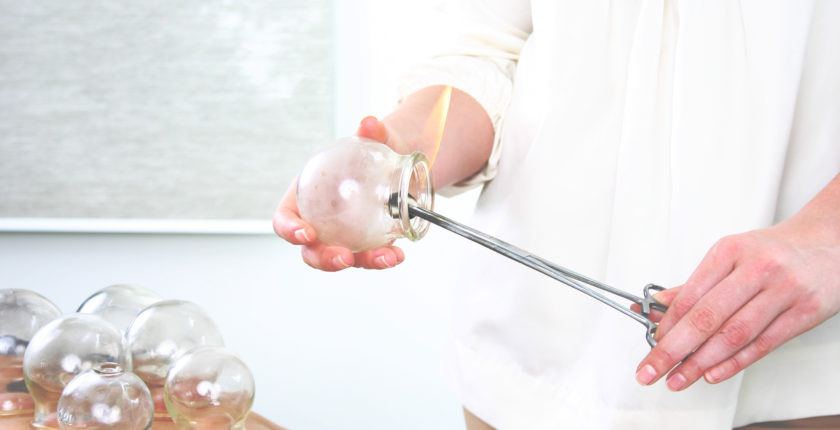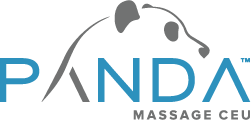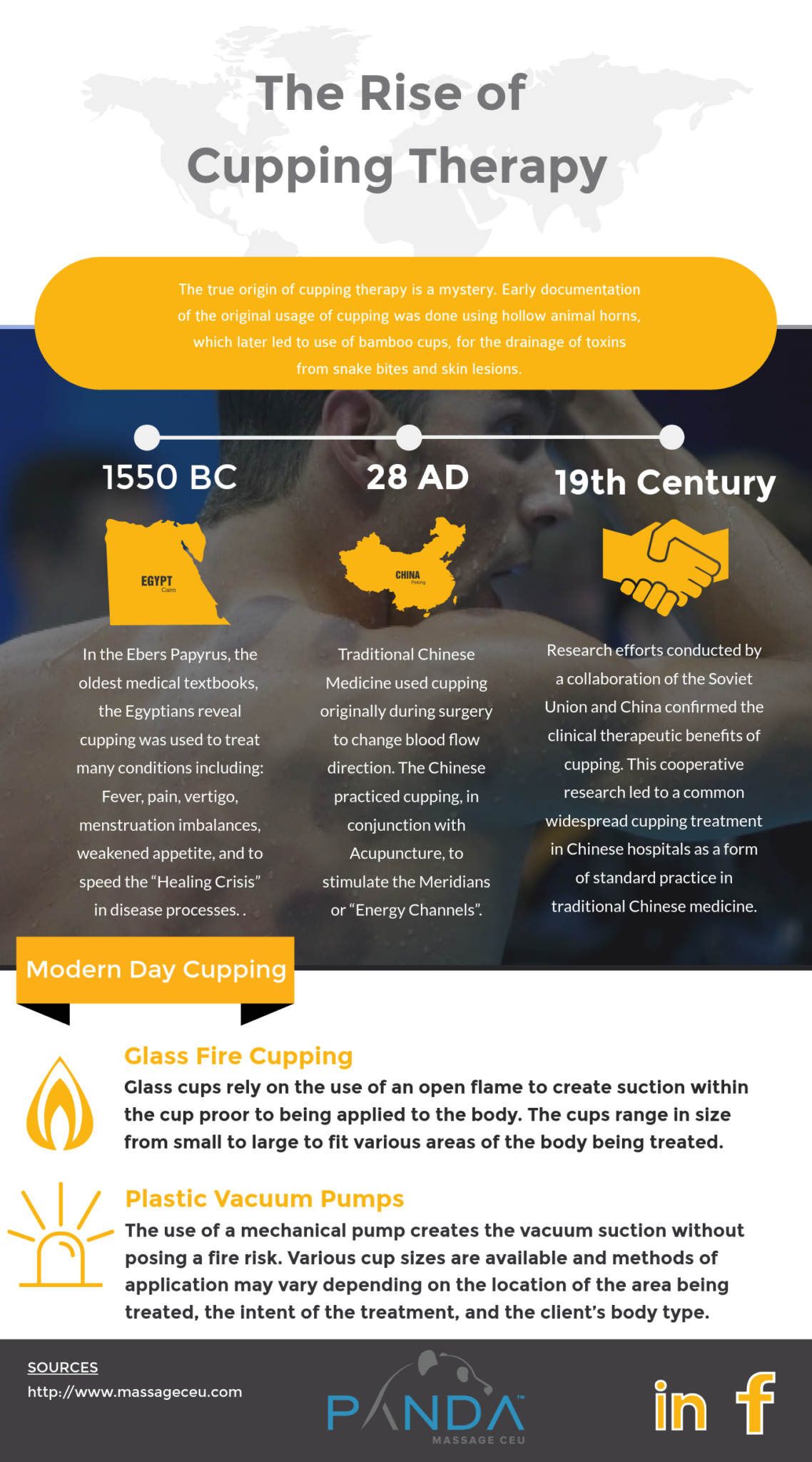The Rise of Cupping in Massage Therapy
- April 12, 2018
- Posted by: massageceu
- Category: Licensed massage therapist ceus online massage ceus

As a massage therapist, you have a lot of tools in your arsenal when it comes to providing your clients with relief, relaxation, and healing. Whether it’s deep tissue massage, hydrotherapy, or even hot stone therapy, you have plenty of options available to you. Different clients have different needs, and there are specific massage techniques that can be utilized depending on an individual client’s history. Your assessment of a client as part of their initial intake is what should ultimately guide your decision making when it comes to formulating a treatment plan. Lately, though, more and more massage therapists have experienced clients coming in and asking about cupping therapy. They’re curious about how it could fit into their treatment, and what benefits it might be able to offer them. Is it painful? Is it right for me? Should I try it, or am I better off just continuing with other methods of therapy? These are some of the questions that massage therapists today might hear from clients when it comes to cupping. And, as a massage practitioner yourself, you might be curious about cupping yourself. Maybe it’s not something you learned much about during your time spent obtaining your massage education, and you’re wondering what it’s all about. Is it something you can incorporate into your sessions with clients? How complicated is it? Are there any potential risks associated with cupping techniques? If so, what are they, and how can they be avoided? If you really want to dive in, it’s worth taking an online massage CEU course in cupping therapy. This allows you to use online massage CEUs in order to fulfill your annual (or biannual) continuing education requirements, as determined by your particular state. An in-depth course is important if you really want to incorporate cupping into your daily practice. Detailed coverage of the finer points of the technique is beyond the scope of this blog article. But, not everyone is ready to take the plunge and sign up for an online massage CEU course. If you’re looking to learn more about cupping, including what it is and how it works, then this blog post is a great place to start. In this article, we’ll talk about:
- What cupping is
- How cupping works
- What its therapeutic effects are
- Risks associated with cupping
- Celebrity cupping and cupping in popular culture
- How to incorporate cupping into your massage practice
- Where you can learn new massage techniques like cupping
…and more.
Ready to learn more about cupping? Let’s get started!
What is cupping?
You might be asking yourself questions like: “how is cupping going to add to my practice?” “What can it offer my clients?” But before we can answer those questions, we need to address a much more basic one: what exactly is cupping?
Cupping therapy goes back thousands of years, and is rooted in Traditional Chinese Medicine (TCM). While it’s only recently become a popular form of treatment in the West, it’s been used in Asia for centuries to treat a variety of symptoms in patients. Even before it become popularized as part of the Chinese medicinal canon, cupping was used in ancient Egypt. One of the world’s oldest medical texts is written on Egyptian papyrus, and it refers to cupping therapy being used as early as 1,550 B.C.!
Those who seek out cupping often request it for its reputed therapeutic effects. According to some practitioners, cupping can help with pain, poor blood flow, inflammation, and other issues. In some circles, cupping is considered to be akin to a form of deep-tissue massage. It’s commonly used by acupuncturists and Chinese medical practitioners to achieve therapeutic goals as outline according to traditional Chinese medicinal theory. Massage therapists use it too in order to stimulate tissue deep within the body.
How does cupping work?
Cupping works through a vacuum mechanism. By creating a vacuum inside of a cup of some kind and placing it on a client’s back, the skin is pulled up into the cup and a therapeutic effect can be achieved.
Historically, a wide variety of materials have been used for the actual cups themselves. In the past, both bamboo and various forms of earthenware have served as cups. Now, it’s common to see cups come in the form of glass or silicone.
So, how is cupping actually performed? First, the practitioner will create a hot flame inside of the cupping container. This is commonly an alcohol swab or a cotton ball soaked in alcohol that’s set on fire and held with a pair of tweezers or a similar safety device. This flame is held inside of the cup until it heats up significantly.
Next, the heated cup is placed against the patient’s skin. As the air inside the cup begins to cool, a vacuum is created. The resulting vacuum effect pulls the client’s skin up away from their body and into the cup. When this happens, the blood vessels under the skin expand significantly. As a result, the bulbous-looking skin inside the cup becomes red and puffy looking. The cup is then left in place for a period of time, usually several minutes.
While this is the most common approach to cupping, there are other methods used as well. Nowadays, it’s not unusual to see a practitioner using a pump of some kind to create the vacuum effect into of each cup rather than relying on flame and heat.
What are the therapeutic effects of cupping?
Now that you know a little bit more about the history of cupping therapy and how it actually works in practice, you might be wondering: what are its therapeutic benefits?
As of now, there aren’t all that many clinical studies out there that we can point to when it comes to cupping. Instead, the benefits of cupping are primarily supported by anecdotal evidence — which by definition doesn’t adhere to the standards of formal, control group-based scientific studies.
However, many people have reported positive therapeutic benefits associated with cupping. While there aren’t studies in place to support all of these claims, it’s worth reviewing them.
These are some of the reported therapeutic effects of cupping:
- Pain reduction: This is easily the most common reason that people seek out cupping therapy. One systematic review of a collection of other cupping studies found a positive correlation between cupping therapy and pain relief in certain patient populations when compared with drug therapy. A correlation was also found between cupping and the reduction of pain that accompanies respiratory problems.
In this instance — from a massage therapy perspective — cupping is thought to work to release tissue at a deep level in the body. This is a big part of the reason why athletes will use cupping therapy to recover between events (see below).
When it comes to pain reduction, we often see cups used in a handful of common areas on the body, including the neck, the shoulders, and the lower back. - Respiratory issues: As mentioned above, cupping is said to provide benefits related to respiratory issues. It has been reported that cupping can reduce healing time when it comes to recovering from a cold and relieve some of the discomfort associated with upper respiratory illnesses and infections. This is thought to be related to the improved blood flow and lymphatic drainage associated with the application of cupping.
- Relaxation: At first glance, you might think that cupping would be the opposite of relaxing. How could having the skin on your back sucked up into a cup be relaxing? Surprisingly, though, cupping can have a therapeutic effect on clients when it comes to promoting relaxation. The same way that acupuncture can be uncomfortable at first but ultimately lead to a more relaxed state, the initial discomfort of cupping often gives way to a sense of peace and release.
Are there any potential risks associated with cupping?
According to HealthLine, there aren’t many risks or side effects typically associated with cupping. That said, the treatment isn’t completely innocuous. If performed incorrectly or on a client for which it might be contraindicated, cupping can be counterproductive or even harmful.
Some clients who have received cupping treatment report feelings of nausea, dizziness, and/or light headedness. Others experience profuse sweating. Once the cups are removed, the site where each cup was located will tend to produce a uniform, characteristic bruise. Bruising can remain for a number of days (or even weeks) following a session. Scarring of the skin is another potential risk, as is infection. However, infection and scarring can be prevented by employing the proper technique and taking necessary precautions.
It’s important to remember, too, that cupping often involves the use of an open flame. It’s important to exercise caution when preparing and applying cups to a patient in order to prevent potential accidents or other adverse effects.
Has anyone famous received cupping treatments?
If you tuned into the 2016 Olympic games, you likely saw some amazing athleticism. You also probably saw something else, too: Olympic swimmer Michael Phelps covered cupping marks. Phelps’ notoriety as an athlete cast cupping into the limelight, and suddenly thousands of people were running Google searches attempting to determine what those “weird purple dots” on Michael Phelps were all about.
As it turns out, though, Michael Phelps isn’t the only celebrity who loves cupping therapy. Jennifer Aniston and Gwyneth Paltrow have both been spotted with cupping marks, as has Victoria Beckham. Posting a picture on Twitter featuring the telltale signs of a cupping treatment, Jessica Simpson tweeted: “Love it!” And while David Arquette admitted that the practice could feel a “little creepy,” he nevertheless describes himself as a fan of the procedure.
How can you incorporate cupping into your massage practice?
At this point, you may be sold on the potential advantages that cupping could confer on your practice and your clients. And, with the increasing number of celebrities and public figures tweeting about their love of cupping, you’ll likely find more and more clients asking you if you’re trained to offer them the treatment. The question is, though: how can you actually make cupping a part of your regular massage practice?
That’s a tricky question. If you received training for cupping while in massage school, you might be good to go. Some massage programs offer a considerable amount of hands-on cupping experience to their students. If you attended one of these programs, there may not be much that you need to do apart from getting yourself a set of cups and getting started.
However, not everyone went through an educational program that offered this kind of training. If you’re unsure of where to get started, we highly recommend taking an online massage CEU course that focuses on cupping.
Where can you learn new massage techniques?
When it comes to continuing your massage education, you have a couple of options.
The first involves signing up for traditional CEU courses: the kind that are offered in-person. While these can be great for some people, attending an in-person training can be time consuming and cost prohibitive. They’re great when they fit your schedule and budget, but they’re not for everyone.
The other option — and one which is becoming increasingly popular — is to take an online massage CEU course. In order to maintain your licensure in the majority of states, you’ll need to obtain a certain number of CEU hours each year (or every two years, depending on your state’s requirements). Attending an online massage CEU course is a great way to fulfill this requirement.
If you’re looking for an online course that focuses specifically on cupping, look no further! Panda™ offers an exclusive CEU course that will teach you everything you need to know.
Why choose Panda?
There may be other online massage CEU options out there, but none of them compare to Panda. What makes Panda Massage CEU the best?
High quality courses
We offer the higher quality courses you’ll find anywhere, online or otherwise.
Unique offerings
Our cupping CEU course is just one of many unique and interesting class options.
Professionally narrated
Some online massage CEU courses feature unprofessional, choppy narration that’s hard to follow. Panda’s classes are professional narrated to maximize student retention.
Video
Not all online courses feature video. Ours do.
Work at your own pace
One of the greatest advantages of taking an online course versus an in-person one is the ability to work at your own pace. With Panda, you can press pause and pick up where you left off whenever it’s convenient for you.
Affordable pricing
Panda is the ideal intersection of quality and affordability. Learn more about our pricing here. To register for a class, click here.

